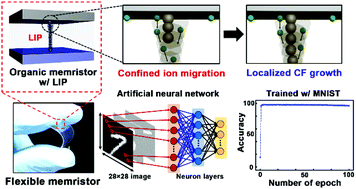Reliable organic memristors for neuromorphic computing by predefining a localized ion-migration path in crosslinkable polymer†
Abstract
In flexible neuromorphic systems for realizing artificial intelligence, organic memristors are essential building blocks as artificial synapses to perform information processing and memory. Despite much effort to implement artificial neural networks (ANNs) using organic memristors, the reliability of these devices is inherently hampered by global ion transportation and arbitrary growth of conductive filaments (CFs). As a result, the performance of ANNs is restricted. Herein, a novel concept for confining CF growth in organic memristors is demonstrated by exploiting the unique functionality of crosslinkable polymers. This can be achieved by predefining the localized ion-migration path (LIP) in crosslinkable polymers. In the proposed organic memristor, metal cations are locally transported along the LIP. Thus, CF growth is achieved only in a confined region. A flexible memristor with an LIP exhibits a vastly improved reliability and uniformity, and it is capable of operating with high mechanical and electrical endurance. Moreover, neuromorphic arrays based on the proposed memristor exhibit 96.3% learning accuracy, which is comparable to the ideal software baseline. The proposed concept of predefining the LIP in organic memristors is expected to provide novel platforms for the advance of flexible electronics and to realize a variety of practical neural networks for artificial intelligence applications.



 Please wait while we load your content...
Please wait while we load your content...